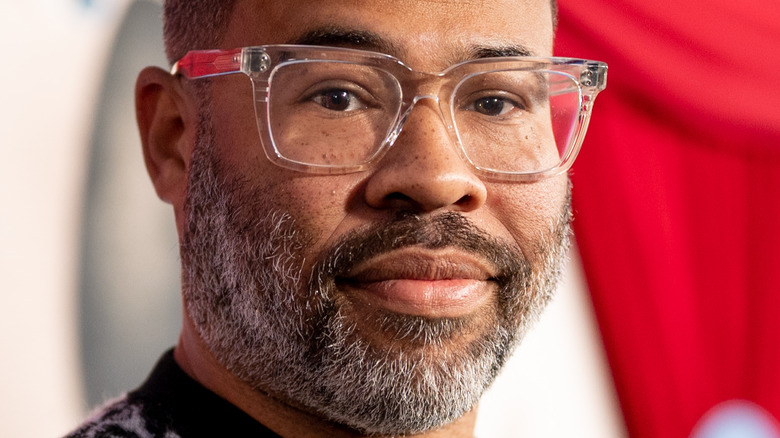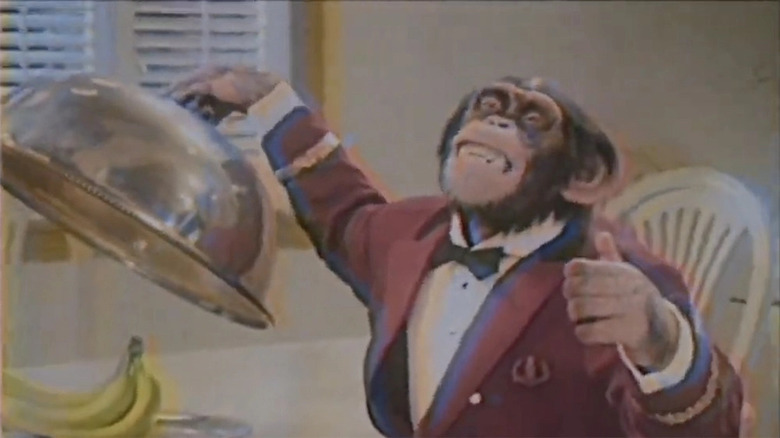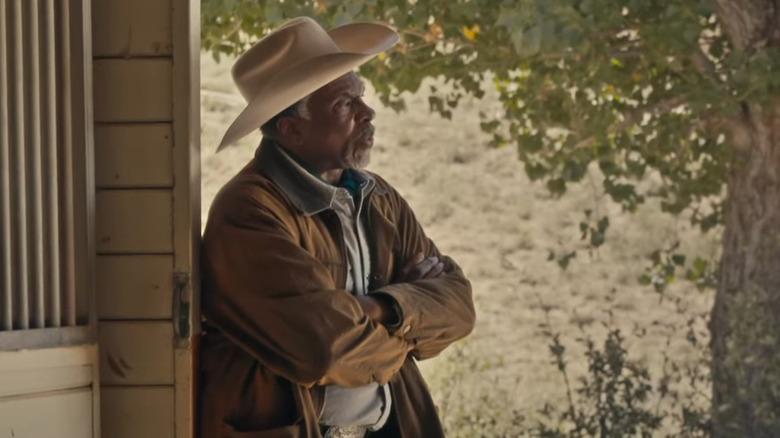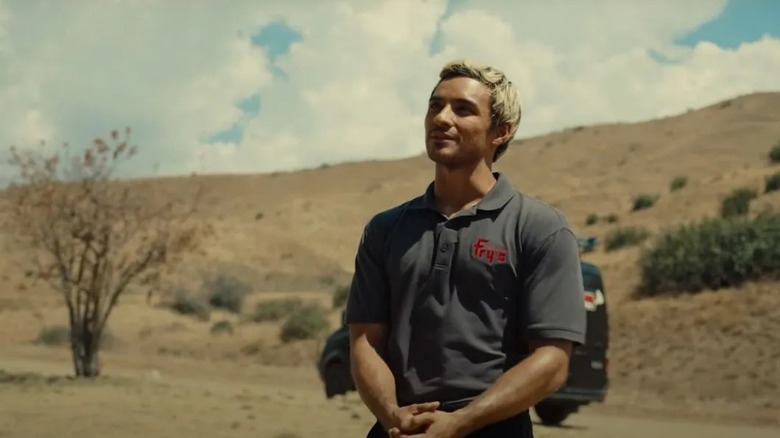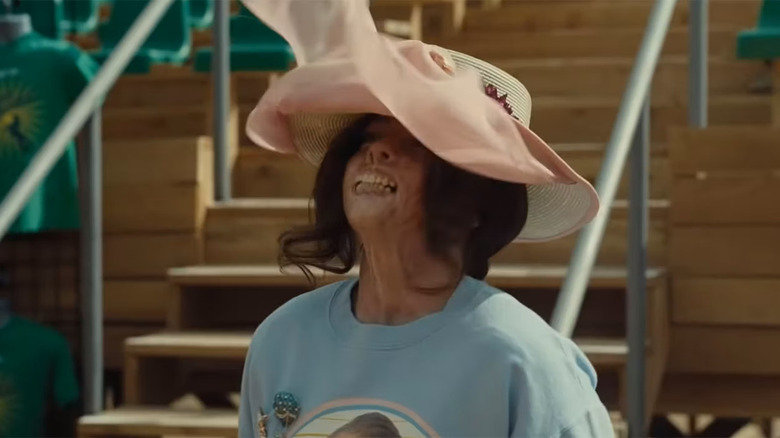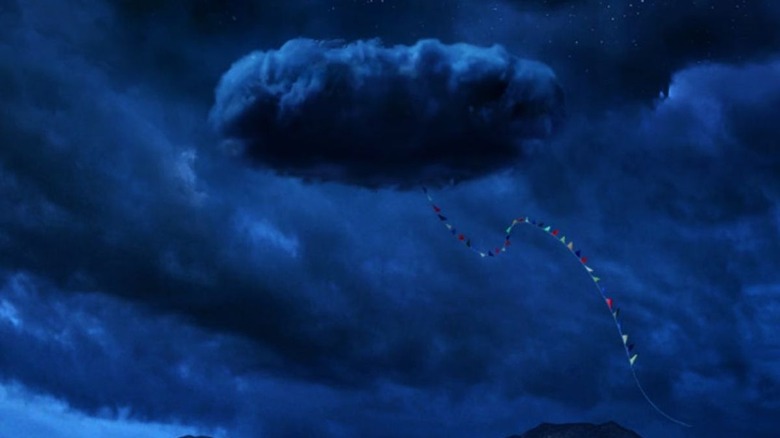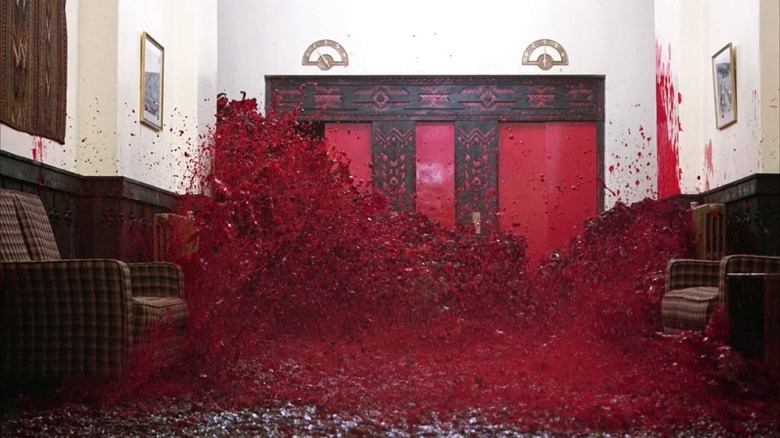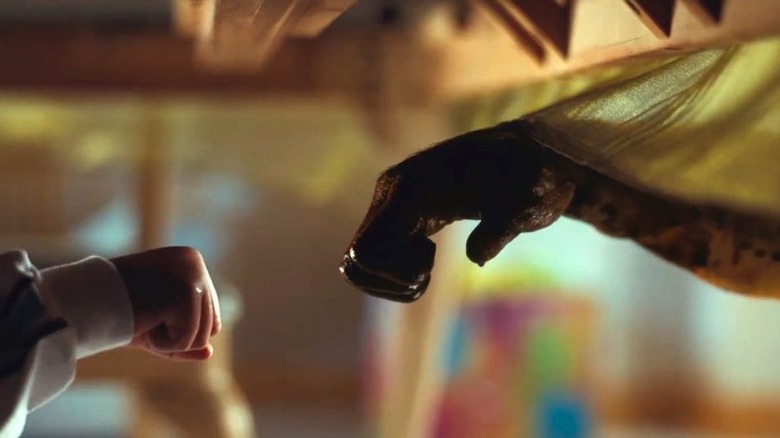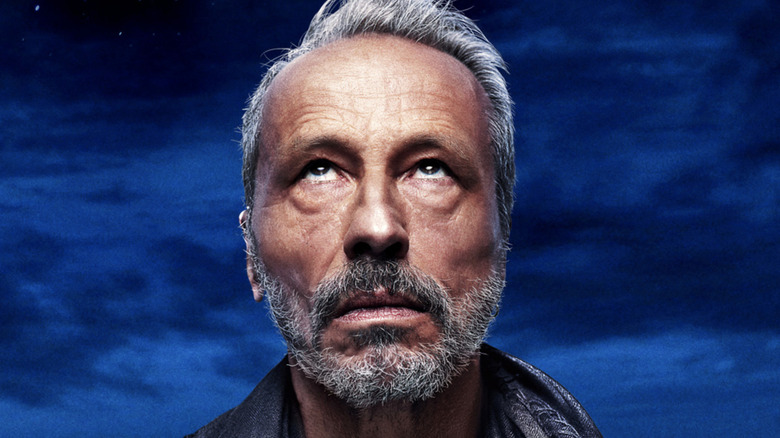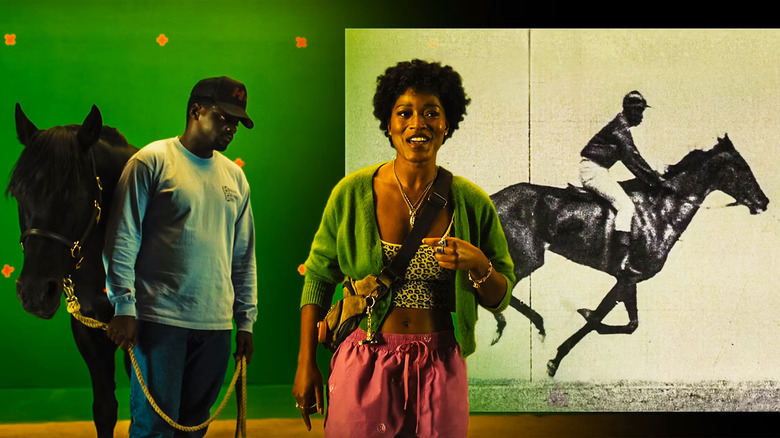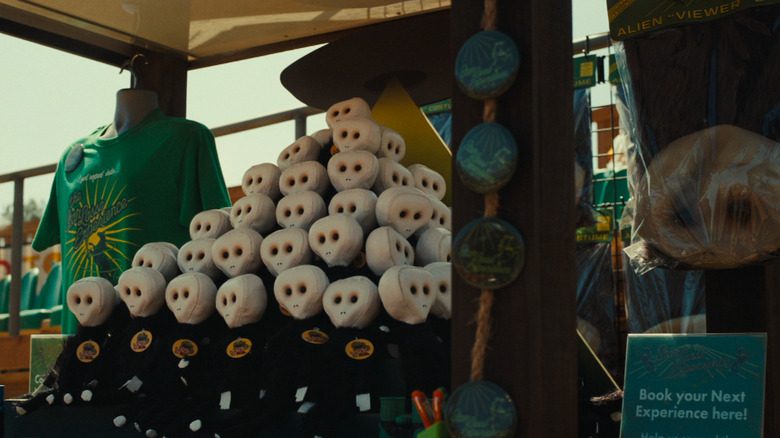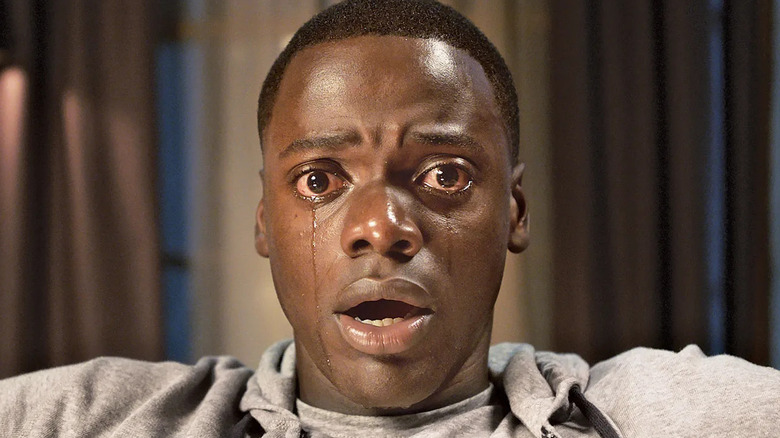Nope Moments That Really Upset Fans The Most
Contains spoilers for "Nope"
There is no horror director like Jordan Peele, and there is no horror movie like "Nope." Like its predecessors "Get Out" and "Us," Peele's latest film is singular – despite the myriad comparisons reviewers will draw between "Nope" and other films, as they will for every film, none of them will hit the mark dead on. That's because, again like its predecessors, "Nope" is a constantly moving target. It glides between (or should we say, ominously hovers over) genres such as alien movie, creature feature, comedy, and any number of different social commentaries, handling every one of them as deftly as Peele ever has. But no matter what hat "Nope" is wearing at any given moment, it always succeeds in constantly upsetting its viewers.
Fans have already taken to social media and discussion sites like Twitter and Reddit en masse to discuss "Nope," voicing their shock and disturbance over various moments in the film. The discussions alone make it clear that there are disturbing moments aplenty, from the already-infamous Gordy sequences, to the horrifying digestion sequence, to even (or especially) the underlying message and symbolism. Prepare yourself for the rain of blood and nickels that are the "Nope" moments that really upset fans the most.
The opening scene
There is no limit to what could be said about the opening scene of "Nope," a viscerally horrifying experience that raises a hundred questions but leaves viewers not wanting to ask any of them. After the title cards end and a very Peele-esque bible quote runs its course, the opening scene begins.
It's almost entirely quiet, and comprised of a single, simple shot. In frame is a television studio and the set of a standard '80s or '90s sitcom. Aside from a few cowering audience members in the background, the only beings in the scene are a young girl – seen only as a pair of motionless legs lying on stage – and a chimp, wearing a birthday hat, covered in blood. It's clear that the chimp, who we later find out is named Gordy, has run amok and savagely mauled the girl, who may or may not be dead.
Chimp attacks on their own are terrifying, but coming at the very start of a film supposedly about aliens, it's as upsetting as can be. One Reddit user, gigi_c16 wrote that, "It's truly the scariest scene in my opinion in this movie... It makes you want to look away but the feeling of needing to know what happens next is curiosity taking over."
Keith David's death
Following the opening scene, which as we'll discuss later, is only the tip of the Gordy iceberg, the following sequence reveals screen legend Keith David to play the patriarch of the Haywood clan, a family of horse tamers for Hollywood productions. While David's character, Otis Haywood Sr., is engaging in a routine conversation with his son, O.J., he abruptly stops moving and sags atop the horse he is riding. After he's rushed to the hospital, we find out that a nickel fell from the sky, through Otis Sr.'s eyeball, and embedded itself in his brain, killing him slowly and painfully. While that would be upsetting enough, some fans have picked up on a more insidious way in which the scene raised their ire and/or bile.
Just as the manner of death was gruesome, so was what it signified. As Reddit user StanTheCentipede pointed out, "The overall theme of Nope is trying to profit off things you really probably shouldn't profit from... what kills Keith David's character is money falling from the f**king sky." The ideas of callous greed and tokenisation are major themes of the movie, which make Otis Sr.'s death by a literal financial token especially tough in hindsight.
The praying mantis
The vast majority of "Nope" moments that upset fans, upset in the right way. They either delivered on the film's promise of horror or similarly delivered on its expected social commentary, in both cases nailing that sweet spot so typical of Peele's work. But a few of the upsetting moments are the wrong kind of upsetting because they're (presumably) unintentional and annoying. Case in point: the praying mantis, which has already begun to generate its own discussion threads for its absurdity and convenience to the plot.
The insect in question appears at the exact moment the Haywoods try to film the saucer. It covers the camera throughout the entire alien encounter and flies away of its own accord the moment the saucer leaves, preventing any useful recording. As Reddit user RandomNPC commented, the use of the mantis felt "weak" and "flimsy," as "Their setup would've worked fine if not for the praying mantis though, and they abandoned that setup after 1 try." They're right, given that O.J. specifically comments on how rare the bugs are in that area, making the moment even more frustrating. And though other users, like Merchant-Crow, consider the insect's presence just another "bad miracle," that doesn't make it any less upsetting for many.
The digestion scene
By the sheer number of comments, it's obvious that one of the most upsetting sequences in "Nope" is when the saucer sucks up the crowd at Jupe's show and begins digesting them alive. From that short description, it's already apparent why the scene upset so many, but the experience of the scene, as well as the implications it creates, are surprisingly even worse.
Peele shot the scene as though the audience were just another meal for the saucer, and so we follow the terrifying, jumbled mass of people up into the saucer and see up close the cramped prison of alien flesh they're forced into. Reddit user DJProducing pointed out the "great deal of claustrophobia" in the scene, and ThisisthSaleh replied that "For (the crowd) to fight their way up, only to find more dead bodies was just unsettling sh*t." The saucer is no alien aircraft but rather an animal itself, which meant that the crowd was now trapped in its bowels.
An exchange between users GravyBear10 and ProudWheeler, respectively, sums up the scene's implications well: "So what, they're being slowly digested while suspended in air for hours?" "I guess until it blenders them or something."
The screams
As upsetting as the digestion scene is, it is foreshadowed and followed by equally disturbing moments caused by the creature's same predation and metabolism. Sporadically throughout "Nope," chillingly vague screams echo throughout the canyon, usually when the saucer is in sight. The movie spends a long, long time sprinkling the screams throughout before it ever even hints at an explanation. On top of that, the screams seem to come from multiple beings at once, sounding like any number and combination of people and horses. Even before the spine-chilling sounds are explained, they managed to upset fans to their cores.
Reddit user fil42skidoo was one of the first to cite the pervasive screams as one of the most upsetting parts of "Nope," saying that "Their screams from the clouds was horrible too...and then suddenly cut off. Chills." Responders like JunkyDragon called the sounds "super disturbing" and buzzdash123 called them "genuinely horrifying."
The screams make the digestion scene worse, implying that the saucer carries its victims in its stomach for days, slowly digesting them, and likewise, the digestion scene makes the screams worse, implying that all the vaguely terrifying sounds fans heard for hours were the cries of dozens of beings suffering. The combination was novel and effective, or as kerriganfan writes, "I'd never seen that in a monster movie before. The monster's victims still alive inside it and screaming, giving you a sense of the being's location but in a way that is more terrifying than useful. And then it swallows them."
Blood rain
Rounding out the trilogy of truly upsetting moments from "Nope" that directly stem from the saucer's metabolism is the blood rain scene. The scene, which is already being compared to the infamous elevator blood scene from "The Shining," sees Em and Angel trapped in the ranch-house overnight, the saucer menacingly hovering directly over them. Like we had seen before, small metal objects began falling from the sky, clinking against the house's walls and windows. Then, the rain switches to a torrent of dark red blood, which repaints the otherwise white building red for the rest of the movie.
As we gradually come to realize, the blood and all the metal objects that had ever fallen from the sky were actually the saucer creature expelling its waste. The blood was presumably its version of pee and the metal objects were inorganic and therefore inedible – it's fair to think of them as being thrown up by the saucer. Reddit user Gio_H called the scene "absolutely horrifying" and Dawesfan claimed that the scene "will forever be engraved in my brain." Dawesfan later went on to praise the scene's masterful tension in a longer post, which reads in part "we see the Jean Jacket vomit the objects it cannot digest, and you wonder what's next. Will it destroy the house attempting to kill Em and Angel? Nope, blood starts to slowly pour in a terrifying Shinning-esque sequence."
6:13 of havoc
We already covered the opening scene, which jumpstarts fan terror with images of a bloody Gordy and his victim, but fortunately/unfortunately, "Nope" has much more Gordy violence to parade out later in the movie. While the first shots of Gordy only imply grizzly violence, later sequences brazenly show it off firsthand, and they are easily the most talked-about moments other than the saucer and its victims.
We learn what went wrong with Gordy – another bad miracle occurred, popping a few balloons while the cast was filming a "Gordy's Home" episode. The unexpected loud noises overpowered the chimp's training and sent him into a fight or flight mode, causing him to viciously maul the actors on stage with him. The one exception is a young Jupe, a child actor on the show, who Gordy discovers hiding under a table only after he's calmed down, and so decides to leave the young boy be.
The sequence did not sit well with fans at all. User bisforbatman wrote that "The entire scene... was so nerve-wracking, especially when he sees young Jupe under the table and just stares into the camera. My anxiety was so high." Likewise, calvinwick26 said, "The Gordy scene was masterfully done and stuck with me as truly unsettling."
Holst is an idiot
Alongside the frustratingly inconvenient praying mantis, the choices and actions of Antlers Holst may be the most annoying parts of "Nope." The character, superbly played by Michael Wincott, is presented throughout the film as a true master of his craft – he's an old-school, guerrilla filmmaker and virtuosic cinematographer. He chooses his projects carefully, based on their merit, novelty, and artistic value (except when he's forced to pay the bills with commercials) and it's clear that he values integrity and intelligence over all else in his career. That's why it's so aggravating when Holst agrees to help the Haywoods film the saucer and completely blows it.
The supposedly expert filmmaker decides to take both himself and his never-before-seen, world-changing footage of the saucer creature and voluntarily feed himself and it to the saucer. After all this time trying to capture the perfect shot of the creature, he succeeds, but then decides to permanently throw it all away. The act has prompted a number of dedicated discussion threads, such as "What was up with Antler Holst in the climax?" "My theory about Holst & his sacrifice" and the most direct of all, "what antlers holst did was very stupid can you guys explain why he would've done that?"
The saucer's death
With all of the intersecting messages in "Nope" centered around the dangers of dehumanization, disrespecting living beings, trying to control predators, and putting spectacle ahead of empathy, it's an odd choice for the movie to end with the creature, by this point given the name Jean Jacket, murdered by Em and torn into a million pieces.
The scenes involving Gordy and his effect on Jupe's later life were meant as examples of what not to do. They told fans that those who try to dominate dangerous animals and harm them for selfish gain risk violent retribution and moral compromise. The same is true for the scenes involving O.J. and his horse Lucky, and how the pair were treated on a commercial set – ignored, degraded, and depersonalized, O.J. and Lucky were both liable to rebel.
The theme supposedly carries into the third act, as O.J. hatches a plan to tame Jean Jacket, or at least come to a mutual understanding with it. And that planned worked for a while, or as user Ding_a_Ling__ put it "that was JJ showing respect to OJ. OJ challenged it and won, and after that revealed its true self to him, seeing him as an equal and let him live." As terracottahoneyy added "Respect is given, shown, and taken in most animal species, it's not a human specific characteristic." For many fans, who noted the genuine bond (however animalistic) between O.J. and Jean Jacket, the creature's death is a confusing one.
No E.T.s
By its end, "Nope" reveals itself to be anything but an alien movie. True, in the thematic sense of otherness, the movie certainly revolves around alienation, but in the literal sense, "Nope" is totally devoid of E.T.s. What is initially believed to be a spaceship containing little green men (the film's working title, by the way) turns out to be an organism itself, a massive, flying predator that sucks people and other animals into its saucer-like body to eat them, not probe them. And while the film's characters still seem to believe the creature is alien in origin, there is no proof, nor even solid evidence, in the film to suggest that it is anything but a previously-undiscovered species of animal.
This twist, turning an alien invasion movie into a creature feature, is playful and fresh, but that doesn't stop fans of alien invasion movies from being disappointed. Peele certainly billed the movie as an alien movie, even citing the recent release of previously-unseen government footage of U.F.O.s (or as Angel would say, U.A.P.s) as an inspiration. But the real monster was merely an angry Earth animal, designed after Earth's aquatic life (or, if you believe some imaginative fans, the creature is actually the real-world inspiration for angels).
The moral
Ultimately, as with "Get Out" and "Us," a huge part of the terror that stays with you after watching "Nope" is in its message. The film plays with many themes, but all of them come back to exploitation (as user Mofu_263 explained). Every one of its villains is engaged in enterprises that exploit less privileged or less powerful others for profit (and as user JohnWhoHasACat pointed out, Peele even questions if he himself is one of them), while every one of its heroes chooses to respect and care for the other, never letting greed disrupt their empathy.
All of the film's most upsetting moments – though they're already terrifying on their own – happen specifically to exploiters and are carried out by exploitees. Lucky's personal space was invaded, so he bucked and kicked out at the commercial crew. Gordy was used and ridiculed, so he mauled his costars. Jupe tried to coerce and control Jean Jacket, so it ate him, his family, and his whole crowd alive. Then the TMZ photographer disrespected Jean Jacket, so it ate him, too.
Many fans left theaters after seeing "Nope" upset, some due to frustrating filmmaking choices, some due to dashed expectations, many due to the sheer horror of it all, but many more may leave upset for reasons they don't even fully understand, and that's the beauty of both Peele and "Nope."
